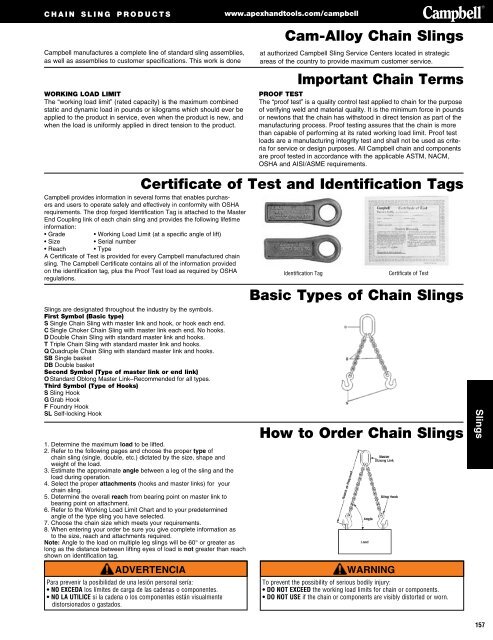Apex - Campbell
You also want an ePaper? Increase the reach of your titles
YUMPU automatically turns print PDFs into web optimized ePapers that Google loves.
c h a i n s l i n g p r o d u c t s<br />
www.apexhandtools.com/campbell<br />
<strong>Campbell</strong> manufactures a complete line of standard sling assemblies,<br />
as well as assemblies to customer specifications. This work is done<br />
WORKING LOAD LIMIT<br />
The “working load limit” (rated capacity) is the maximum combined<br />
static and dynamic load in pounds or kilograms which should ever be<br />
applied to the product in service, even when the product is new, and<br />
when the load is uniformly applied in direct tension to the product.<br />
Slings are designated throughout the industry by the symbols.<br />
First Symbol (Basic type)<br />
S Single Chain Sling with master link and hook, or hook each end.<br />
C Single Choker Chain Sling with master link each end. No hooks.<br />
D Double Chain Sling with standard master link and hooks.<br />
T Triple Chain Sling with standard master link and hooks.<br />
Q Quadruple Chain Sling with standard master link and hooks.<br />
SB Single basket<br />
DB Double basket<br />
Second Symbol (Type of master link or end link)<br />
O Standard Oblong Master Link–Recommended for all types.<br />
Third Symbol (Type of Hooks)<br />
S Sling Hook<br />
G Grab Hook<br />
F Foundry Hook<br />
SL Self-locking Hook<br />
ADVERTENCIA<br />
Para prevenir la posibilidad de una lesión personal sería:<br />
• NO EXCEDA los límites de carga de las cadenas o componentes.<br />
• NO LA UTILICE si la cadena o los componentes están visualmente<br />
distorsionados o gastados.<br />
Cam-Alloy Chain Slings<br />
at authorized <strong>Campbell</strong> Sling Service Centers located in strategic<br />
areas of the country to provide maximum customer service.<br />
Important Chain Terms<br />
PROOF TEST<br />
The “proof test” is a quality control test applied to chain for the purpose<br />
of verifying weld and material quality. It is the minimum force in pounds<br />
or newtons that the chain has withstood in direct tension as part of the<br />
manufacturing process. Proof testing assures that the chain is more<br />
than capable of performing at its rated working load limit. Proof test<br />
loads are a manufacturing integrity test and shall not be used as criteria<br />
for service or design purposes. All <strong>Campbell</strong> chain and components<br />
are proof tested in accordance with the applicable ASTM, NACM,<br />
OSHA and AISI/ASME requirements.<br />
Certificate of Test and Identification Tags<br />
<strong>Campbell</strong> provides information in several forms that enables purchasers<br />
and users to operate safely and effectively in conformity with OSHA<br />
requirements. The drop forged Identification Tag is attached to the Master<br />
End Coupling link of each chain sling and provides the following lifetime<br />
information:<br />
• Grade • Working Load Limit (at a specific angle of lift)<br />
• Size<br />
• Serial number<br />
• Reach • Type<br />
A Certificate of Test is provided for every <strong>Campbell</strong> manufactured chain<br />
sling. The <strong>Campbell</strong> Certificate contains all of the information provided<br />
on the identification tag, plus the Proof Test load as required by OSHA<br />
regulations.<br />
1. Determine the maximum load to be lifted.<br />
2. Refer to the following pages and choose the proper type of<br />
chain sling (single, double, etc.) dictated by the size, shape and<br />
weight of the load.<br />
3. Estimate the approximate angle between a leg of the sling and the<br />
load during operation.<br />
4. Select the proper attachments (hooks and master links) for your<br />
chain sling.<br />
5. Determine the overall reach from bearing point on master link to<br />
bearing point on attachment.<br />
6. Refer to the Working Load Limit Chart and to your predetermined<br />
angle of the type sling you have selected.<br />
7. Choose the chain size which meets your requirements.<br />
8. When entering your order be sure you give complete information as<br />
to the size, reach and attachments required.<br />
Note: Angle to the load on multiple leg slings will be 60° or greater as<br />
long as the distance between lifting eyes of load is not greater than reach<br />
shown on identification tag.<br />
Identification Tag<br />
How to Order Chain Slings<br />
WARNING<br />
Certificate of Test<br />
Basic Types of Chain Slings<br />
To prevent the possibility of serious bodily injury:<br />
• DO NOT EXCEED the working load limits for chain or components.<br />
• DO NOT USE if the chain or components are visibly distorted or worn.<br />
Slings<br />
157

















